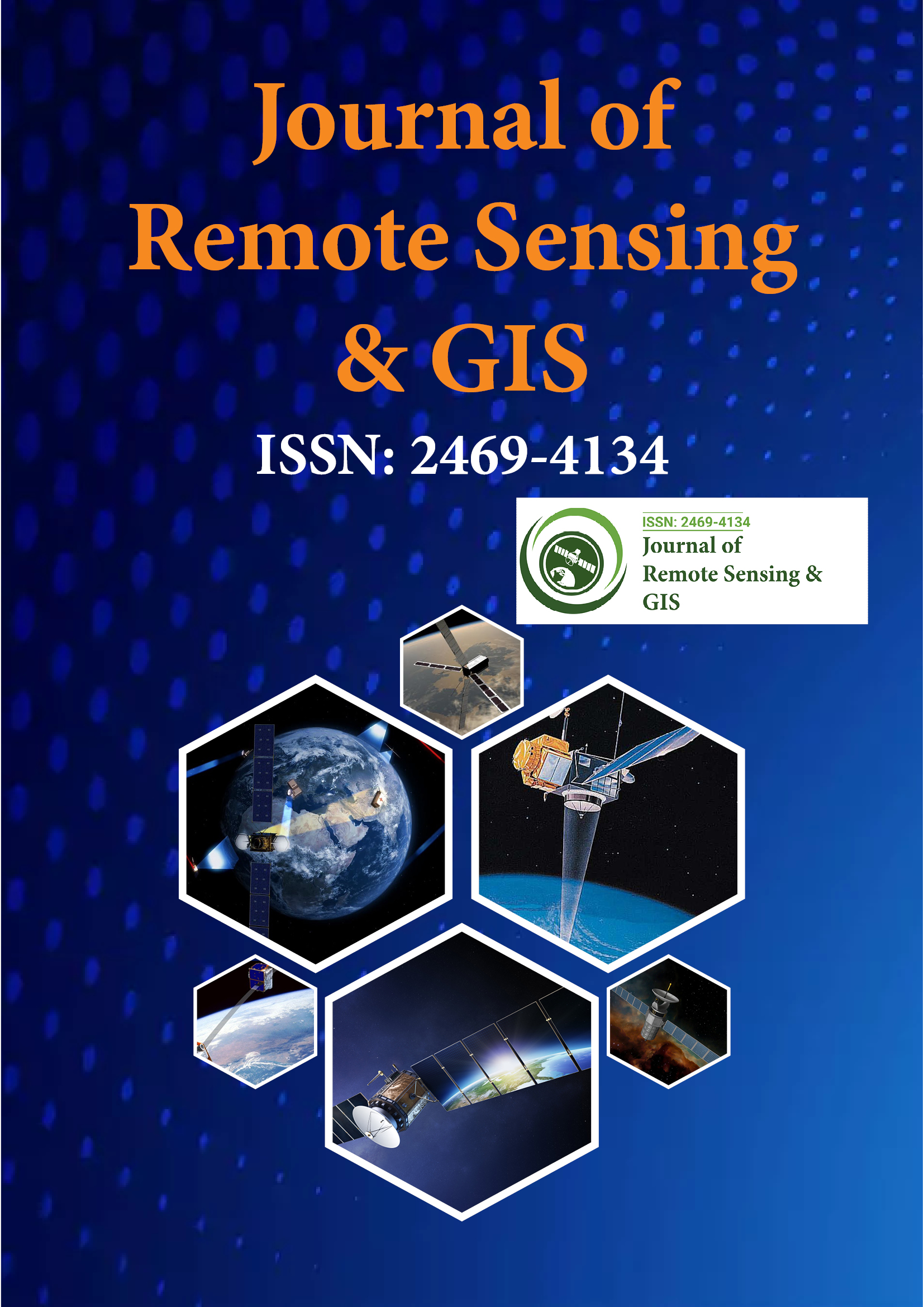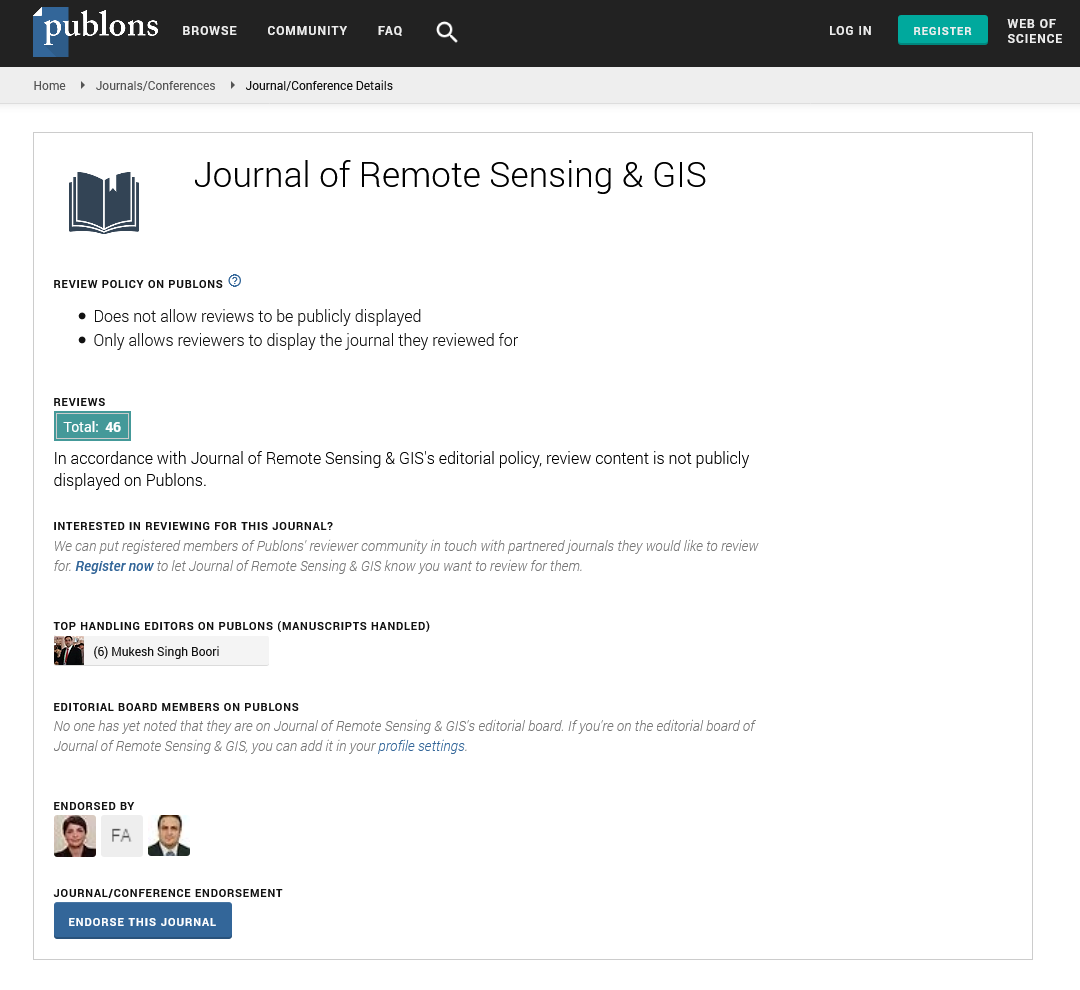Indexed In
- Open J Gate
- RefSeek
- Hamdard University
- EBSCO A-Z
- OCLC- WorldCat
- Publons
- International Scientific Indexing
- Euro Pub
- Google Scholar
Useful Links
Share This Page
Journal Flyer

Open Access Journals
- Agri and Aquaculture
- Biochemistry
- Bioinformatics & Systems Biology
- Business & Management
- Chemistry
- Clinical Sciences
- Engineering
- Food & Nutrition
- General Science
- Genetics & Molecular Biology
- Immunology & Microbiology
- Medical Sciences
- Neuroscience & Psychology
- Nursing & Health Care
- Pharmaceutical Sciences
Perspective - (2024) Volume 13, Issue 4
Remote Sensing in Disaster Response: Enhancing Preparedness and Recovery Efforts
Simon Sharafat*Received: 25-Nov-2024, Manuscript No. JGRS-24-28064; Editor assigned: 27-Nov-2024, Pre QC No. JGRS-24-28064 (PQ); Reviewed: 12-Dec-2024, QC No. JGRS-24-28064; Revised: 20-Dec-2024, Manuscript No. JGRS-24-28064 (R); Published: 27-Dec-2024, DOI: 10.35248/2469-4134.24.13.364
Description
Natural calamities, including earthquakes, floods, cyclones and wildfires, pose significant threats to human lives and ecosystems. The ability to monitor, predict and respond to such disasters effectively is essential for reducing their impact. Remote sensing technology has become an indispensable tool for disaster management, showing extensive capabilities for gathering and analyzing data over large geographic areas. This technology utilizes sensors mounted on satellites, drones or aircraft to collect information, enabling informed decision-making throughout the disaster management cycle.
Early warning and prediction
Remote sensing plays a significant role in early warning systems, which aim to predict and provide alerts about impending natural disasters. For instance, meteorological satellites equipped with thermal and radar sensors monitor atmospheric conditions, detecting anomalies that signal extreme weather events such as hurricanes or typhoons. Similarly, data from remote sensing systems are used to model earthquake risk zones by analyzing tectonic plate movements and geological structures. These predictive capabilities allow authorities to prepare evacuation plans, allocate resources and minimize casualties.
The integration of remote sensing data with Geographic Information Systems (GIS) enhances disaster forecasting by visualizing potential hazard zones. This combination is instrumental in mapping flood-prone areas based on rainfall patterns and river basins. As a result, early interventions, such as the construction of flood defenses or the relocation of vulnerable populations, become feasible.
Real-time monitoring
During an ongoing disaster, remote sensing provides real-time data essential for assessing the situation and guiding response efforts. High-resolution satellite imagery shows an overview of affected regions, capturing details such as damaged infrastructure, displaced populations and blocked transportation routes. Drones equipped with cameras and sensors are particularly effective in obtaining detailed imagery of areas that are otherwise inaccessible due to floods, landslides, or other disruptions.
Radar sensors on satellites, such as Synthetic Aperture Radar (SAR), can penetrate cloud cover and provide data regardless of weather conditions. This is particularly useful in tracking hurricanes, monitoring flood extents and detecting changes in topography caused by landslides. These capabilities help emergency responders prioritize their actions, ensuring timely delivery of aid and rescue operations.
Post-disaster assessment
After a disaster, remote sensing is invaluable for assessing the extent of damage and planning recovery efforts. By comparing pre- and post-event imagery, authorities can estimate the impact on infrastructure, natural resources and human settlements. For example, satellite images can identify areas where buildings have collapsed during earthquakes, enabling targeted rebuilding efforts.
Remote sensing also facilitates environmental impact assessments. Forest fires, for instance, leave scars that can be monitored through satellite imagery to evaluate the loss of vegetation and habitat. This information is important for planning reforestation initiatives and habitat restoration. Additionally, flood extent mapping helps estimate agricultural losses and supports compensation and insurance claims for affected farmers.
Long-term disaster preparedness
Beyond immediate response and recovery, remote sensing contributes to long-term disaster preparedness by helping create risk maps and vulnerability assessments. These maps highlight regions prone to specific hazards, enabling urban planners and policymakers to implement mitigation strategies. For example, seismic hazard maps guide the design of earthquake-resistant buildings, while land use maps inform zoning regulations to minimize flood risks.
Satellite data also support climate change studies, which are essential for understanding and preparing for future disaster risks. Monitoring changes in sea levels, glacier melting and deforestation provides insights into environmental trends that could exacerbate natural calamities. This information allows governments and organizations to develop adaptive strategies, such as building sea walls or diversifying water sources.
Integration with emerging technologies
The effectiveness of remote sensing in disaster management is enhanced by integrating it with other technologies such as Artificial Intelligence (AI), Internet of Things (IoT) and cloud computing. AI algorithms analyze vast datasets from remote sensing platforms, identifying patterns and anomalies that might go unnoticed through manual analysis. For example, AI can automatically detect wildfire hotspots or predict the path of a cyclone based on historical data and current observations.
IoT devices, including ground-based sensors and weather stations, complement remote sensing by providing localized data. These devices feed real-time information into remote sensing systems, enhancing the accuracy of disaster predictions and assessments. Cloud computing facilitates the storage and processing of large volumes of remote sensing data, ensuring that insights are delivered quickly to decision-makers.
Citation: Sharafat S (2024). Remote Sensing in Disaster Response: Enhancing Preparedness and Recovery Efforts. J Remote Sens GIS. 13:364.
Copyright: © 2024 Sharafat S. This is an open-access article distributed under the terms of the Creative Commons Attribution License, which permits unrestricted use, distribution and reproduction in any medium, provided the original author and source are credited.

